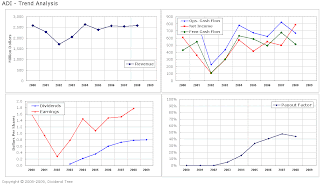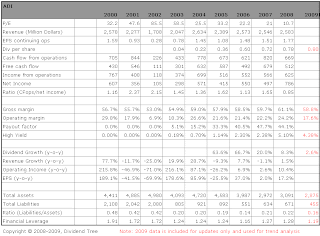Analog Devices, Inc. engages in the design, manufacture, and marketing of analog, mixed-signal, and digital signal processing integrated circuits used in industrial, communication, computer, and consumer applications. Its products are used in communications applications that include wireless handsets and wireless base stations, as well as products used for high-speed access to the Internet, including central office networking equipment. Risk Parameter Calculation Quality of Dividends Fair Value Calculation The range of fair value is calculated as $18.6 to $24.5. I determined by taking average (for high value) of above five parameters and then subtracting it with half the standard deviation (for low value). Conclusion Full Disclosure: No position at the time of writing. This article was written by Dividend Tree. If you enjoyed this article, please vote for it by clicking the Buzz Up! button below.
ADI is not a dividend achiever and has started paying dividends since last 5 years only. The most recent dividend increase was in May 2008. I am impressed by ADI’s strong balance sheet and free cash flow. My objective here is to analyze if ADI has any potential to be a good dividend growth stock and how does it rate on my scale of risk-to-dividends.
Trend Analysis
Here I am looking at trends for past 10 years of corporation’s revenue and profitability. These parameters should show consistently growth trends. The trend charts and data summary are shown in images below.
Here I use the corporation’s financial health to assign a risk number for measuring risk-to-dividends. The risk number for risk-to-dividends is 2.0. This is a medium risk category as per my 3-point risk scale. The increased payout factor and sluggish EPS growth rate (relative to its historical average) makes it a medium risk to dividends.
This section measures the dividend growth rate, duration of growth, consistency over a period of past five years.
Qualitative Analysis
Analog Devices, Inc., is about 43 year old technology based company. It is built on the foundation of innovation by its founder Ray Stata who is still associated with the company. It has survived all the ups and downs of technology industry. One aspect that I like is its ability to command 50% gross margins on its products.
I like ADI’s diversified revenue stream and geographical presence. Overall, it is a US based company that will provide hedge against dollar fluctuation and proxy for foreign developed/emerging markets. It truly has a very strong balance sheet that includes free cash flow and practically zero debt. I also like the fact that company continues to remain focused on its core competency which gives it higher gross margin products. I stop short of starting any position because of (1) my concern whether management will continue its dividend policy; (2) changing competitive landscape with more competitors joining in, which was not the case earlier; and (3) current pricing is higher than my fair value range. I would be willing to take dividend risk provided I get an opportunity to buy at lower end of my fair value range.
Murphy’s Law – I hate Murphy
-
According to Webster’s Dictionary, Murphy’s Law is defined as an
observation that says, “anything that can go will go wrong.” Well, I
freaking hate Murph...
7 hours ago







